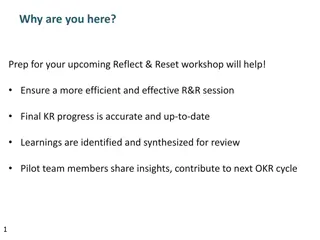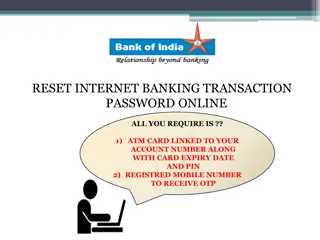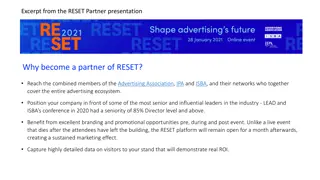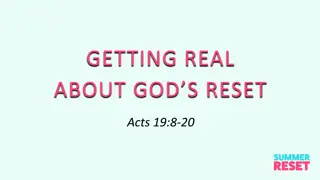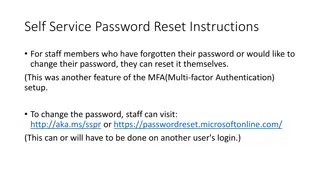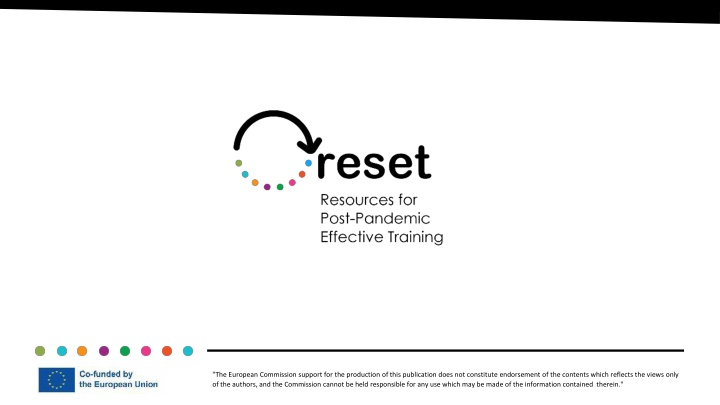
Quality Training for Students with Special Needs: Empowering Learners Module
Explore a comprehensive module supported by the European Commission focusing on identifying and supporting students with physical, mental, or neurological disabilities. Learn about coaching, tutoring roles, assistive technology, and creating supportive learning environments for special needs students.
Download Presentation

Please find below an Image/Link to download the presentation.
The content on the website is provided AS IS for your information and personal use only. It may not be sold, licensed, or shared on other websites without obtaining consent from the author. If you encounter any issues during the download, it is possible that the publisher has removed the file from their server.
You are allowed to download the files provided on this website for personal or commercial use, subject to the condition that they are used lawfully. All files are the property of their respective owners.
The content on the website is provided AS IS for your information and personal use only. It may not be sold, licensed, or shared on other websites without obtaining consent from the author.
E N D
Presentation Transcript
"The European Commission support for the production of this publication does not constitute endorsement of the contents which reflects the views only of the authors, and the Commission cannot be held responsible for any use which may be made of the information contained therein."
Quality digital training for students with special needs ref. DigCompEdu Area 5: Empowering Learners Partner: Aalborg Handelsskole "The European Commission support for the production of this publication does not constitute endorsement of the contents which reflects the views only of the authors, and the Commission cannot be held responsible for any use which may be made of the information contained therein."
Goals At the end of this module you will be able to: Special needs Identify Students with physical, mental or neurological disabilities Coaching and tutor roles Know the coaching and tutor roles Supportive learning environment Setup and design a supportive learning environment Assistive technology Know how Assistive technology can support student with special needs. "The European Commission support for the production of this publication does not constitute endorsement of the contents which reflects the views only of the authors, and the Commission cannot be held responsible for any use which may be made of the information contained therein."
Index of contents Providing education for all Coaching & tutor roles Assistive technology Supportive learning environment Special needs 1.1 Providing education for all 1.2 How to Identify students with special educational needs 2.1 Coaching and tutoring 2.2 Working with students 2.3 About tutoring 2.4 Students are different 3.1 How can we help students with special needs? 3.2 What can you do to help students with dyslexia? 3.3 What can you do to help students with mental disabilities? 3.4 What can you do to help students with physical disabilities? 3.5 Creating a supportive learning environment 3.6 Classroom strategies 4.1 How can we help students with special needs ? 4.2 Text-to-speech software 4.3 Speech-to-text software 4.4 Screen reader software 4.5 OCR and Scan-to- document "The European Commission support for the production of this publication does not constitute endorsement of the contents which reflects the views only of the authors, and the Commission cannot be held responsible for any use which may be made of the information contained therein."
Special needs 1.1 Providing education for all Students Students with special needs are students with physical, mental or neurological disabilities. These students may need support with their learning and schoolwork. Exaples Some examples of students with special needs include those who have: - Dyslexia (e.g. reading or writing) - Physical disabilities (e.g. mobility, vision) - Mental health issues (e.g. anxiety, depression) - Other learning difficulties. (e.g. time scheduling, overview etc. ) "The European Commission support for the production of this publication does not constitute endorsement of the contents which reflects the views only of the authors, and the Commission cannot be held responsible for any use which may be made of the information contained therein."
Special needs 1.1 Providing education for all Special Education Service Special Education Service Students with special needs may qualify for special education services if they have a disability that impacts their ability to learn. Examples Examples Counselling and mentoring Reading and writing guidance Instructional support Assistive technology Special education software Customized courses Special education programs provide students with the tools they need to succeed in school and life. "The European Commission support for the production of this publication does not constitute endorsement of the contents which reflects the views only of the authors, and the Commission cannot be held responsible for any use which may be made of the information contained therein."
Special needs 1.2 How to Identify students with special educational needs Observation Teachers and other school staff can observe students' behaviors Assessments Formal assessments such as standardized tests & classroom assessments. A A B B Referral process Referrals are reviewed by professionals, who will determine if the student is eligible for special educational Parent and teacher input can provide valuable information about a student's strengths, weaknesses. C C D D support. 7 "The European Commission support for the production of this publication does not constitute endorsement of the contents which reflects the views only of the authors, and the Commission cannot be held responsible for any use which may be made of the information contained therein."
Special needs It's important to note that the process for identifying students with special educational needs and providing special educational support varies by country and education system In some cases students may be identified as needing special educational support based on specific criteria or disability categories, while in other cases, the focus is on the student's individual needs and how they can be supported to succeed in school. "The European Commission support for the production of this publication does not constitute endorsement of the contents which reflects the views only of the authors, and the Commission cannot be held responsible for any use which may be made of the information contained therein."
Special needs Summing up: Students with special needs Students with physical, mental or neurological disabilities. Providing education for all Special education programs provide students with the tools they need to succeed in school and life. Identify students with special educational needs Observation, Assessments, Parent and teacher input, Referral process Process for identifying students Varies by country and education system "The European Commission support for the production of this publication does not constitute endorsement of the contents which reflects the views only of the authors, and the Commission cannot be held responsible for any use which may be made of the information contained therein."
Special needs Please answer the following questions: Which of these is a special need? Passivity Absurdity Dyslexia Special Education Service helps with? Counselling and mentoring Financial aid Transportation Process for identifying students Is always done by a teacher Varies by country and education system Is newer standardized testing Which of these can help Identify students with special? Sleeping Singing Observation "The European Commission support for the production of this publication does not constitute endorsement of the contents which reflects the views only of the authors, and the Commission cannot be held responsible for any use which may be made of the information contained therein."
Unit test solutions Here are the answers: Which of these is a special need? Passivity Absurdity Dyslexia helps with? Counselling and mentoring Financial aid Transportation Special Education Service Process for identifying students Is always done by a teacher Varies by country and education system Is newer standardized testing Which of these can help Identify students with special? Sleeping Singing Observation "The European Commission support for the production of this publication does not constitute endorsement of the contents which reflects the views only of the authors, and the Commission cannot be held responsible for any use which may be made of the information contained therein."
Coaching and tutor roles 2.1 Coaching and tutoring Coaching and tutoring are both types of educational support that can be provided to students to help them succeed in school. Coaching Coaching Coaching typically refers to the provision of specialized instruction or training in a specific subject or skill, with the goal of helping the student improve their performance in that area. Coaching may be provided by a teacher, a specialist, or an outside coach, and may take place in a group or individual setting. Tutoring Tutoring Tutoring, on the other hand, typically refers to one-on-one instruction provided by a tutor to help a student understand a specific subject or skill. Tutors may be teachers, subject matter experts, or other qualified individuals who provide personalized instruction and support to help students learn and improve their skills. Tutoring may take place in a variety of settings, including in-person, online, or in a small group setting. "The European Commission support for the production of this publication does not constitute endorsement of the contents which reflects the views only of the authors, and the Commission cannot be held responsible for any use which may be made of the information contained therein."
Coaching and tutor roles 2.2 Working with students Work with a student A coach can work with a student to identify their specific needs and goals, and can provide customized instruction and support to help the student progress and succeed. Variety of subjects Coaching can be used to support students in a variety of subjects and areas, including academics, athletics, the arts, and other extracurricular activities. Coaching may also involve providing feedback and guidance, setting goals and benchmarks, and monitoring progress over time. It can be particularly beneficial for students who are struggling with a particular subject or who need extra support to meet academic or personal goals. "The European Commission support for the production of this publication does not constitute endorsement of the contents which reflects the views only of the authors, and the Commission cannot be held responsible for any use which may be made of the information contained therein."
Coaching and tutor roles 2.3 About tutoring Tutoring is a type of educational support that involves one-on-one instruction provided by a tutor to help a student understand a specific subject or skill. Tutors may be teachers, subject matter experts, or other qualified individuals who provide personalized instruction and support to help students learn and improve their skills. A A B B C C D D Tutoring may take place in a variety of settings, including in-person, online, or in a small group setting Tutoring can be an effective way to support students because it allows for a more individualized and focused approach to learning. 14 "The European Commission support for the production of this publication does not constitute endorsement of the contents which reflects the views only of the authors, and the Commission cannot be held responsible for any use which may be made of the information contained therein."
Coaching and tutor roles 2.4 Students are different Different students learn in different ways, so it can be helpful to use a variety of teaching strategies to support students with special needs. Can be Differentiated instruction, Hands-on activities, Visual aids, Adaptive materials, Assistive technology, individual learning, Cooperative learning. "The European Commission support for the production of this publication does not constitute endorsement of the contents which reflects the views only of the authors, and the Commission cannot be held responsible for any use which may be made of the information contained therein."
Coaching and tutor roles Summing up: Coaching and tutoring Coaching and tutoring Both are types of educational support that can be provided to students to help them succeed in school Working with students Working with students A coach can work with a student to identify their specific needs and goals. Tutoring Tutoring is a type of educational support that helps a student understand a specific subject or skill. Students are different Students are different Different students learn in different ways, so it can be helpful to use a variety of teaching strategies. "The European Commission support for the production of this publication does not constitute endorsement of the contents which reflects the views only of the authors, and the Commission cannot be held responsible for any use which may be made of the information contained therein."
Coaching and tutor roles Please answer the following questions: Coaching may be provided by a? Co-student Friend Specialist Tutoring may take place? In the breaks Online When lecturing a variety of teaching strategies can be? classroom-based teaching Lecturing Assistive technology A tutor can be a? Friend Teacher Neighbor "The European Commission support for the production of this publication does not constitute endorsement of the contents which reflects the views only of the authors, and the Commission cannot be held responsible for any use which may be made of the information contained therein."
Unit test solutions Here are the answers: Coaching may be provided by a? Co-student Friend Specialist Tutoring may take place? In the breaks Online When lecturing a variety of teaching strategies can be? classroom-based teaching Lecturing Assistive technology A tutor can be a? Friend Teacher Neighbor "The European Commission support for the production of this publication does not constitute endorsement of the contents which reflects the views only of the authors, and the Commission cannot be held responsible for any use which may be made of the information contained therein."
Supportive learning environment 3.1 How can we help students with special needs? Providing a supportive learning environment Creating a positive, supportive learning environment can help students with special needs feel comfortable and confident in the classroom This may involve providing a structured and predictable routine, using visual supports and other visual aids, and adapting materials and assignments as needed to meet the student's needs. You can do this using digital aids You can do this using digital aids "The European Commission support for the production of this publication does not constitute endorsement of the contents which reflects the views only of the authors, and the Commission cannot be held responsible for any use which may be made of the information contained therein."
Supportive learning environment 3.2 What can you do to help students with dyslexia? Use of assistive technology Use of assistive technology: There are a variety of assistive technologies, such as text-to-speech software and voice-recognition software, that can help students with dyslexia access written materials. Structured literacy instruction Structured literacy instruction: Structured literacy instruction is a type of reading instruction that emphasizes the structure of language, including phonemes, syllables, and roots. This approach can be particularly helpful for students with dyslexia. Multisensory instruction Multisensory instruction: Multisensory instruction uses a combination of visual, auditory, and kinesthetic (movement-based) techniques to teach reading and spelling. This approach can be effective for students with dyslexia, as it allows them to use multiple senses to process information. Accommodations Accommodations: Accommodations are modifications or adjustments to the learning environment that can help level the playing field for students with dyslexia. Some examples of accommodations include extra time on tests, access to a calculator, or the use of a word processor. Collaboration with specialists Collaboration with specialists: It can be helpful to work with specialists, such as a reading specialist or learning specialist, to identify the specific needs of a student with dyslexia and develop an individualized plan to support their learning. "The European Commission support for the production of this publication does not constitute endorsement of the contents which reflects the views only of the authors, and the Commission cannot be held responsible for any use which may be made of the information contained therein."
Supportive learning environment 3.3 What can you do to help students with mental disabilities? Use of assistive technology Use of assistive technology: Assistive technology, such as text-to-speech software and voice-recognition software, can help students with mental disabilities access written materials and communicate more effectively. Accommodations: Accommodations: Accommodations are modifications or adjustments to the learning environment that can help level the playing field for students with mental disabilities. Some examples of accommodations include extra time on tests, access to a calculator, or the use of a word processor. Collaboration with specialists: Collaboration with specialists: It can be helpful to work with specialists, such as a learning specialist or occupational therapist, to identify the specific needs of a student with a mental disability and develop an individualized plan to support their learning. Structured routines and schedules: Structured routines and schedules: Providing students with mental disabilities with structured routines and schedules can help them feel more secure and better able to manage their time and responsibilities. Visual aids Visual aids: Visual aids, such as pictures, diagrams, and charts, can help students with mental disabilities better understand and retain information. Small group instruction Small group instruction: Small group instruction, in which a student works with a teacher or tutor and a small group of peers, can be particularly effective for students with mental disabilities. This allows for more individualized attention and support. "The European Commission support for the production of this publication does not constitute endorsement of the contents which reflects the views only of the authors, and the Commission cannot be held responsible for any use which may be made of the information contained therein."
Supportive learning environment 3.4 What can you do to help students with physical disabilities? Assistive technology: Assistive technology: Assistive technology, such as adaptive keyboards, speech-to-text software, and switch devices, can help students with physical disabilities access written materials and communicate more effectively. Accommodations: Accommodations: Accommodations are modifications or adjustments to the learning environment that can help level the playing field for students with physical disabilities. Some examples of accommodations include extra time on tests, access to a calculator, or the use of a word processor. Collaboration with specialists Collaboration with specialists: It can be helpful to work with specialists, such as a physical therapist or occupational therapist, to identify the specific needs of a student with a physical disability and develop an individualized plan to support their learning. Adaptive equipment: Adaptive equipment: Using adaptive equipment, such as modified desks and chairs, can help students with physical disabilities participate more fully in the classroom. Visual aids: Visual aids: Visual aids, such as pictures, diagrams, and charts, can help students with physical disabilities better understand and retain information. Small group instruction: Small group instruction: Small group instruction, in which a student works with a teacher or tutor and a small group of peers, can be particularly effective for students with physical disabilities. This allows for more individualized attention and support. "The European Commission support for the production of this publication does not constitute endorsement of the contents which reflects the views only of the authors, and the Commission cannot be held responsible for any use which may be made of the information contained therein."
Supportive learning environment 3.5 Creating a supportive learning environment A positive A positive classroom Encourage open communication, inclusivity, and respect among your students. A safe and supportive environment, can lead to deeper classroomculture culture Clear expectations and rules Clear expectations and rules Clearly communicate your expectations for behavior, work habits, and participation to your students. Use of a digital tools can help create a sense of structure and predictability. learning and growth. A A B B A sense of belonging A sense of belonging Make an effort to engage your students in class activities and discussions, and encourage them to participate. This can help students feel like they are a valued and integral part of the class community. Encourage risk Encourage risk- -taking and mistakes taking and mistakes Making mistakes is a natural part of the learning process. Encourage your students to ask questions, express their ideas, and try new things, even if they might not be perfect C C D D the first time. 23 "The European Commission support for the production of this publication does not constitute endorsement of the contents which reflects the views only of the authors, and the Commission cannot be held responsible for any use which may be made of the information contained therein."
Supportive learning environment 3.6 Classroom strategies It's important to establish clear expectations, create a positive classroom culture, foster a sense of belonging, provide resources and support, encourage risk-taking and mistakes, and show interest in your students. By implementing these strategies, you can create a supportive and nurturing learning environment that helps your students succeed. "The European Commission support for the production of this publication does not constitute endorsement of the contents which reflects the views only of the authors, and the Commission cannot be held responsible for any use which may be made of the information contained therein."
Supportive learning environment Summing up: How can we help students with special needs ? You can do this using digital aids Students with dyslexia Can be supported with text-to-speech software and voice-recognition software Students with mental disabilities Visual aids, such as pictures, diagrams, and charts, can help students with mental disabilities students with physical disabilities Modified desks and chairs, can help students with physical disabilities participate more fully in the classroom. "The European Commission support for the production of this publication does not constitute endorsement of the contents which reflects the views only of the authors, and the Commission cannot be held responsible for any use which may be made of the information contained therein."
Supportive learning environment Please answer the following questions: Supportive learning environment can help students with special needs feel Responsible and aware Comfortable and confident Nervous and unease Accommodations can include Extra time on tests Fewer friends Extra homework Creating a supportive learning environment can be done by? Clear expectations and rules Fewer rules and use of words Shorter breaks You can create a supportive and nurturing learning environment by Play music in the classroom Isolate students with special needs Implement strategies "The European Commission support for the production of this publication does not constitute endorsement of the contents which reflects the views only of the authors, and the Commission cannot be held responsible for any use which may be made of the information contained therein."
Unit test solutions Here are the answers: Supportive learning environment can help students with special needs feel Responsible and aware Comfortable and confident Nervous and unease Accommodations can include Extra time on tests Fewer friends Extra homework Creating a supportive learning environment can be done by? Clear expectations and rules Fewer rules and use of words Shorter breaks You can create a supportive and nurturing learning environment by Play music in the classroom Isolate students with special needs Implement strategies "The European Commission support for the production of this publication does not constitute endorsement of the contents which reflects the views only of the authors, and the Commission cannot be held responsible for any use which may be made of the information contained therein."
Assistive technology 4.1 How can we help students with special needs? Software / Hardware Assistive technology refers to any type of technology or device that is used to help individuals with disabilities or special needs to perform tasks that might otherwise be difficult or impossible "The European Commission support for the production of this publication does not constitute endorsement of the contents which reflects the views only of the authors, and the Commission cannot be held responsible for any use which may be made of the information contained therein."
Assistive technology 4.2 Text-to-speech software Converts written text into spoken words: Converts written text into spoken words: This can be helpful for individuals with visual impairments, dyslexia, or other reading difficulties. Can be used with a variety of different devices: Can be used with a variety of different devices: This can include computers, smartphones, tablets, and other electronic devices. Useful for a variety of different purposes: Useful for a variety of different purposes: For example, individuals can use text-to-speech software to listen to e-books, access online content, or have documents read aloud to them. Customization: Customization: Many text-to-speech programs allow users to adjust the speed and pitch of the spoken words, as well as the voice used to read the text. Helpful for individuals with a variety of different disabilities: Helpful for individuals with a variety of different disabilities: In addition to individuals with visual impairments or reading difficulties, text-to-speech software can be helpful for individuals with cognitive or learning disabilities, hearing impairments, or other challenges. "The European Commission support for the production of this publication does not constitute endorsement of the contents which reflects the views only of the authors, and the Commission cannot be held responsible for any use which may be made of the information contained therein."
Assistive technology 4.3 Speech-to-text software Speech Speech- -to to- -text software text software converts spoken words into written text: This can be helpful for individuals who have difficulty typing or writing due to physical impairments, cognitive difficulties, or other challenges. Can be used with a variety of different devices: Can be used with a variety of different devices: This can include computers, smartphones, tablets, and other electronic devices. Useful for a variety of different purposes: Useful for a variety of different purposes: For example, individuals can use speech-to-text software to take notes, write emails, or create documents. Customization: Customization: Many speech-to-text programs allow users to adjust the speed and pitch of the spoken words, as well as the voice used to read the text. Helpful for individuals with a variety of different disabilities Helpful for individuals with a variety of different disabilities: In addition to individuals with physical impairments or writing difficulties, speech-to-text software can be helpful for individuals with cognitive or learning disabilities, hearing impairments, or other challenges. "The European Commission support for the production of this publication does not constitute endorsement of the contents which reflects the views only of the authors, and the Commission cannot be held responsible for any use which may be made of the information contained therein."
Assistive technology 4.4 Screen reader software Screen reader software Screen reader software is designed to assist individuals with visual impairments: It reads aloud the text and other information displayed on a computer screen, allowing these individuals to access digital content. Can be used with a variety of different devices Can be used with a variety of different devices: This can include computers, smartphones, tablets, and other electronic devices. Different purposes: Different purposes: For example, individuals can use screen reader software to access websites, read emails, or access documents. Customization Customization: Many screen reader programs allow users to adjust the speed and pitch of the spoken words, as well as the voice used to read the text. Helpful for individuals with a variety of different visual impairments: Helpful for individuals with a variety of different visual impairments: This can include individuals with low vision, blindness, or other vision-related challenges. "The European Commission support for the production of this publication does not constitute endorsement of the contents which reflects the views only of the authors, and the Commission cannot be held responsible for any use which may be made of the information contained therein."
Assistive technology 4.5 OCR and Scan-to-document OCR OCR (optical character recognition) software is a type of software that allows users to convert scanned or digital images of text into editable text. OCR software is often used to digitize paper documents or extract text from images for use in other applications. Scan-to-document Scan-to-document software often includes OCR functionality, which allows users to convert scanned documents into editable text. For example, a user might use scan-to-document software to scan a paper document, and then use the OCR functionality to convert the scanned image of the text into editable format. "The European Commission support for the production of this publication does not constitute endorsement of the contents which reflects the views only of the authors, and the Commission cannot be held responsible for any use which may be made of the information contained therein."
Assistive technology Summing up: Software / Hardware Technology or device that is used to help individuals with disabilities or special needs Text-to-speech software Converts written text into spoken words Screen reader software Reads aloud the text and other information displayed on a computer screen. OCR Optical Character Recognition software that convert scanned or images of text into editable text. "The European Commission support for the production of this publication does not constitute endorsement of the contents which reflects the views only of the authors, and the Commission cannot be held responsible for any use which may be made of the information contained therein."
Assistive technology Please answer the following questions: Text-to-speech software Reads books for students Converts written text into spoken words Compile a speech text from random words Speech-to-text software can be used to? Take notes Call a teacher Speak to a friend Screen reader software Scan documents and books Reads aloud the text and other information on a computer screen Converts messages on screen to ibook format. OCR is short for Ocular Clarity Rating Orthogonal Coordinate Response Optical character recognition "The European Commission support for the production of this publication does not constitute endorsement of the contents which reflects the views only of the authors, and the Commission cannot be held responsible for any use which may be made of the information contained therein."
Unit test solutions Here are the answers: Text-to-speech software Reads books for students Converts written text into spoken words Compile a speech text from random words Speech-to-text software can be used to? Take notes Call a teacher Speak to a friend Screen reader software Scan documents and books Reads aloud the text and other information on a computer screen Converts messages on screen to ibook format. OCR is short for Ocular Clarity Rating Orthogonal Coordinate Response Optical character recognition "The European Commission support for the production of this publication does not constitute endorsement of the contents which reflects the views only of the authors, and the Commission cannot be held responsible for any use which may be made of the information contained therein."
Final summary test/1 Consolidate your knowledge answering the following questions: Coaching may be provided by a? Co-student Friend Specialist Special Education Service helps with? Counselling and mentoring Financial aid Transportation Process for identifying students Is always done by a teacher Varies by country and education system Is newer standardized testing a variety of teaching strategies can be? classroom-based teaching Lecturing Assistive technology "The European Commission support for the production of this publication does not constitute endorsement of the contents which reflects the views only of the authors, and the Commission cannot be held responsible for any use which may be made of the information contained therein."
Final summary test/2 Consolidate your knowledge answering the following questions: Supportive learning environment can help students with special needs feel Responsible and aware Comfortable and confident Nervous and unease Text-to-speech software Reads books for students Converts written text into spoken words Compile a speech text from random Creating a supportive learning environment can be done by? Clear expectations and rules Fewer rules and use of words Shorter breaks OCR is short for Ocular Clarity Rating Orthogonal Coordinate Response Optical character recognition "The European Commission support for the production of this publication does not constitute endorsement of the contents which reflects the views only of the authors, and the Commission cannot be held responsible for any use which may be made of the information contained therein."
Final summary test solutions/1 Here are the answers: Coaching may be provided by a? Co-student Friend Specialist Special Education Service helps with? Counselling and mentoring Financial aid Transportation Process for identifying students Is always done by a teacher Varies by country and education system Is newer standardized testing a variety of teaching strategies can be? classroom-based teaching Lecturing Assistive technology "The European Commission support for the production of this publication does not constitute endorsement of the contents which reflects the views only of the authors, and the Commission cannot be held responsible for any use which may be made of the information contained therein."
Final summary test solutions/2 Here are the answers: Supportive learning environment can help students with special needs feel Responsible and aware Comfortable and confident Nervous and unease Text-to-speech software Reads books for students Converts written text into spoken words Compile a speech text from random OCR is short for Ocular Clarity Rating Orthogonal Coordinate Response Optical character recognition Creating a supportive learning environment can be done by? Clear expectations and rules Fewer rules and use of words Shorter breaks "The European Commission support for the production of this publication does not constitute endorsement of the contents which reflects the views only of the authors, and the Commission cannot be held responsible for any use which may be made of the information contained therein."
Awsome! Remember (now you know): Special needs Identify Students with physical, mental or neurological disabilities Coaching and tutor roles Know the coaching and tutor roles Supportive learning environment Setup and design a supportive learning environment Assistive technology Know how Assistive technology can support student with special needs. "The European Commission support for the production of this publication does not constitute endorsement of the contents which reflects the views only of the authors, and the Commission cannot be held responsible for any use which may be made of the information contained therein."
Keep going! project-reset.eu "The European Commission support for the production of this publication does not constitute endorsement of the contents which reflects the views only of the authors, and the Commission cannot be held responsible for any use which may be made of the information contained therein."


